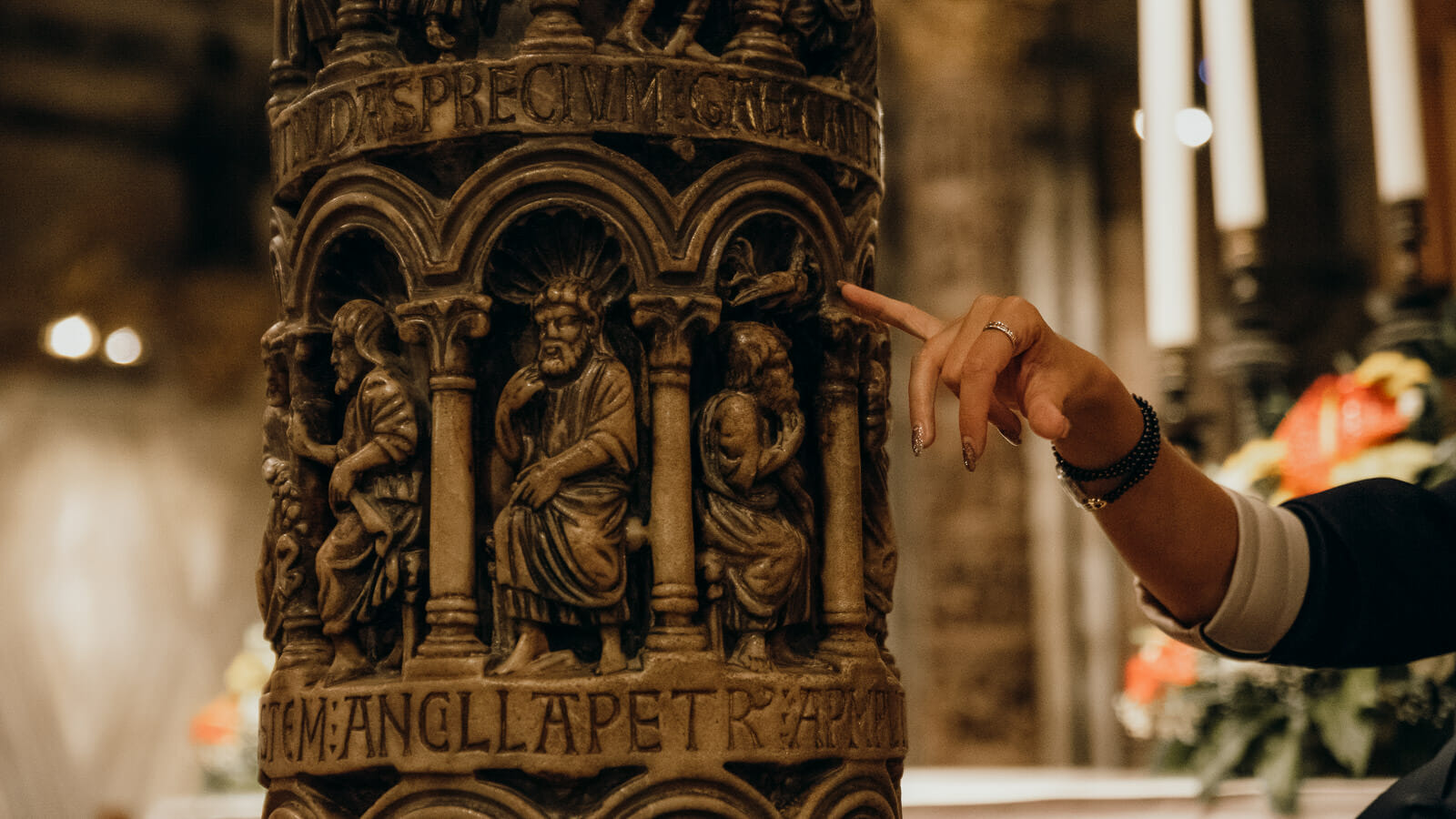
5 Incredible Churches in Venice That Unlock the History of the Floating City
August 25, 2023
Like any Italian city, you might notice Venice has quite a few churches. It’s hard to take a road without running into at least one. Venice has in fact at least 139 churches on its floating islands. And in Italy, churches are much more than religious establishments, they are windows to a city’s past. When you start to think of each chiesa and basilica as a walk-in museum, you won’t want to miss these beautiful – and historic – churches in Venice.

San Marco may be the most famous building in town, but there are plenty of other churches in Venice to explore.
Table of Contents
ToggleThe culture of Venetian churches
As you wander through these gorgeous venetian churches, you might realize many are adjacent to what you will hear called “scuole.” These were actually more of a guild, or confraternity, a group of artisans in a similar profession, or a group connected by religion. They would meet in these areas to discuss charitable and religious endeavors and often would commission a church dedicated to their patron saint.
Many of the churches in Venice were also commissioned by merchants, dedicating a chapel to their families or saints. You can see over ten centuries of architectural styles through the churches of Venice, it is exciting to compare the evolution of art and architecture over this time.
Now that you’re prepped, come along to discover our favorite churches in Venice!

The fascinating history of the city’s art guilds comes to life in Venetian churches such as Saint Mark’s Basilica.
What’s the difference between a chiesa, duomo, and basilica?
Have you ever noticed churches in Italy come with all different names? Some might be known as duomo like the Duomo di Milano, others may be basilica, like the Basilica di San Marco, or simply chiesa. But how do they get these names and what sets them apart?
Well, the word basilica actually comes from the Greek words meaning the house of the king (meaning God in this case). With this logic, the term could be used for any church. Yet it is often reserved for churches of higher importance: both religiously in the Church or artistically due to their decoration. You can also be sure these buildings will have a central nave with two adjacent halls lined with smaller chapels.
A duomo on the other hand comes from the latin Domus, or house. It has the same meaning but tends to be given to the churches most important to the city. While the Vatican may label a church a basilica thanks to its construction or importance, a local city might label a church a duomo to identify the principal local church.
Finally, everything else is simply called a chiesa. Armed with this info, you can enjoy exploring all of the amazing churches in Venice.
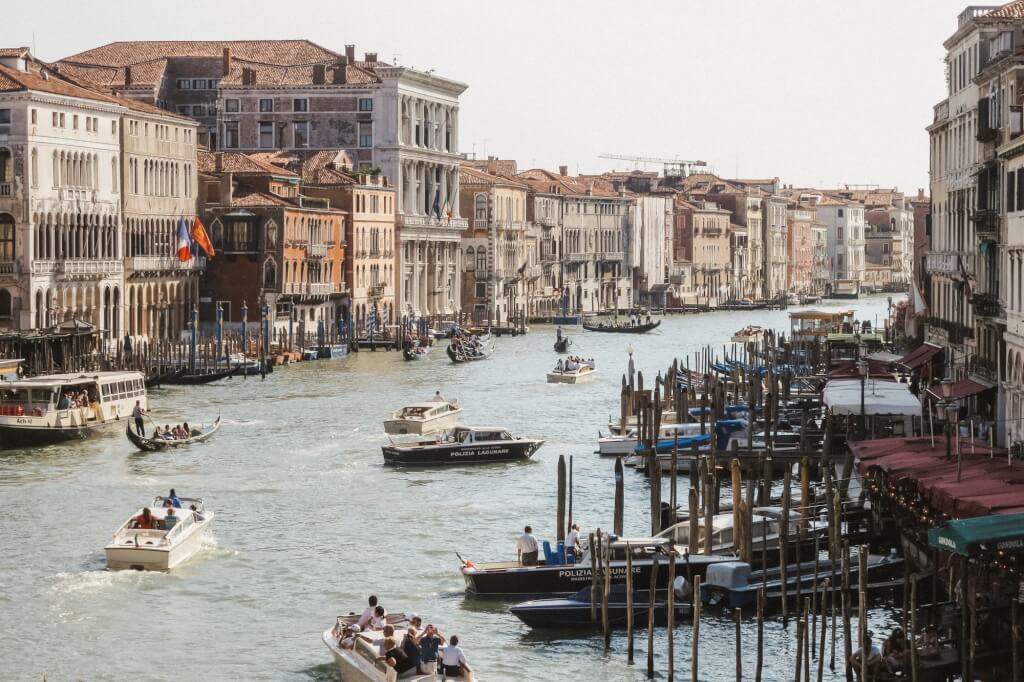
Chiesa, duomo, basilica…you can find some of these buildings along Venice’s Grand Canal!
5 stunning Venetian churches you can’t miss
San Zaccaria
The Church of San Zaccaria is located in the area of Castello, just across the bridge and around the corner from Piazza San Marco. In front of it is a small piazza, known as a campo in Venice. While construction on the church we see today began in 1444 it was not complete until 60 years later. Then it took another 40 before the church was officially consecrated.
Already the facade is enough to impress any passer-by, made of the best Istrian stone, it is divided into 5 sections, known as orders. The lower two were designed by the original architect and follow a late-Gothic style, while the upper were completed by his successor in a Renaissance style. It has a beautiful way of comparing harsh rectangles with softer archways.
Don’t think the facade has it all, inside the church is even more beautiful. You can’t miss the Madonna Enthroned with Child and Saints by Giovanni Bellini, also known as the San Zaccaria alterpiece. This is an early example of Italian artists beginning to explore depth and moving into a new artistic style. Keep looking around and you will see even more works by Tintoretto, Van Dyck, and other great artists of the time.
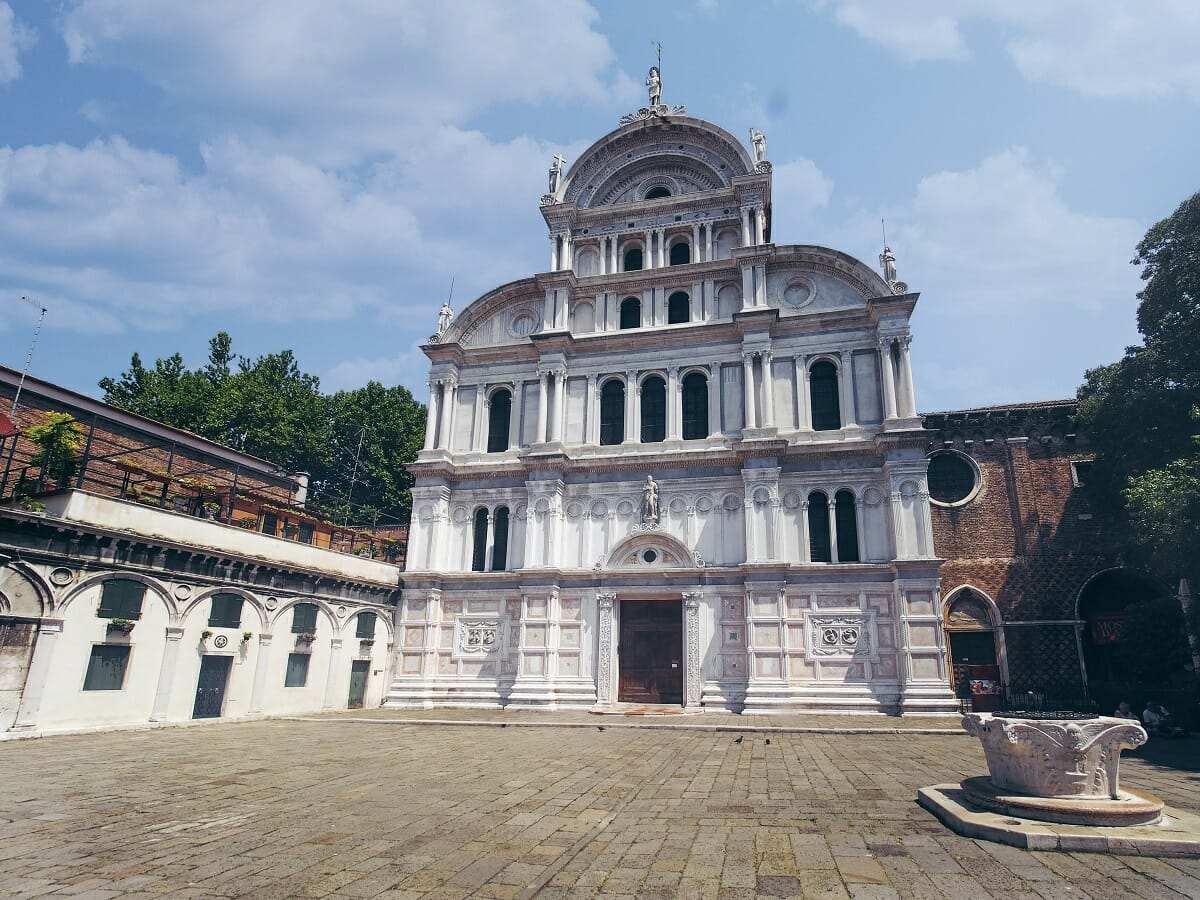
The facade of the 15th century Church of San Zaccaria was created by architect Antonio Gambello. Photo credit: Mehmet Turgut Kirkgoz
Basilica of Santa Maria della Salute
The Basilica of Santa Maria della Salute is another one of our favorite churches in Venice, and for good reason. This stunning basilica, visible in the unmistakable Venetian skyline looking out from the Ponte dell’Accademia, is a tad more modern than others.
This basilica was built in the 17th century at the far tip of the Dorsoduro area. Construction began in 1631 but was not completed until 1687. It has a curious shape, that of an octagon rather than a cross. The towering dome is supported by Baroque-style buttresses and the busy facade is made of Istrian stone.
You might notice this church is not just dedicated to Mary, but to “Saint Mary of Health.” This is because the church was built following a bout of plague in 1630 which had wiped out nearly a third of the local population.

The iconic church of Santa Maria della Salute in the neighborhood of Dorsoduro.
Basilica di San Marco
We couldn’t forget the incredible St. Mark’s Basilica, the star of Venice. This is the main church of Venice and the most stunning you’ll find on the islands.
Originally there was another church that stood here dated to 828, but unfortunately with turmoil in the republic, the church was burned down and rebuilt. The basilica we see today dates to 1063 and was consecrated in 1094. Even so, the full decoration was not complete till later. With the shining mosaics inside not complete until nearly the 1200s and domes being completed later still.
The facade was not considered complete until the 15th century, and the church as a whole was finally considered complete in the 16th century.
You might have to wait a bit of a line to enter, but we promise it is worth it. The dazzling Byzantine style decoration shouldn’t be missed; you’ll be in awe at the glimmering gold mosaics and decoration on every surface.
Another, somewhat sad, thing to notice when entering; you can truly sense how Venice is sinking here. As you walk around you will notice many dips and bumps in the floor, due to the weight and the changing foundations.
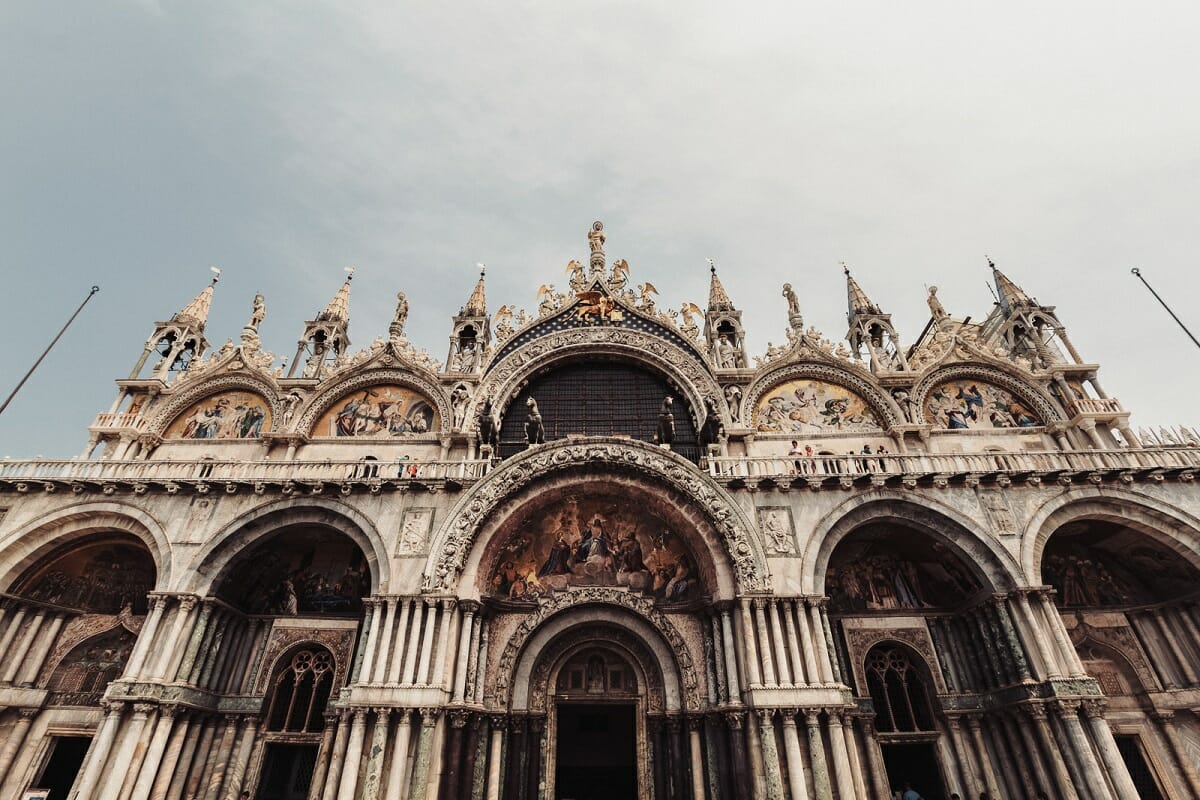
You can find scars and symbols of the Black Death on St Marks Cathedral in Venice.
Basilica of Santa Maria Gloriosa dei Frari
You might hear this church referred to in a few different ways: while its official name is Basilica di Santa Maria Gloriosa dei Frari it is often simply called Basilica dei Frari.
Frari means Friars in local Venetian Dialect, so as you might imagine it was a church under management of the Franciscan Friars. They had the church built in 1250. The humble facade is an Italian Gothic Style entirely in brick, this was in part due to the period, and in part to reflect the Friars’ values of poverty and simplicity.
Don’t be deceived by the outside; however, this church, one of the largest in Venice, is a true gem inside. Step in and enjoy the masterpieces of Titian, Giovanni Bellini, and Donatello. Plus, one of our favorite works by an artist you might not be familiar with – Bartolomeo Vivarini. His Madonna and Child with Saints polyptych has brilliant colors for its age and begins to show us experimentation with the human body and depth.
This church was so loved by artists that two famous painters chose to be buried here! Check out Titian and Antonio Canova’s final resting ground before you leave.
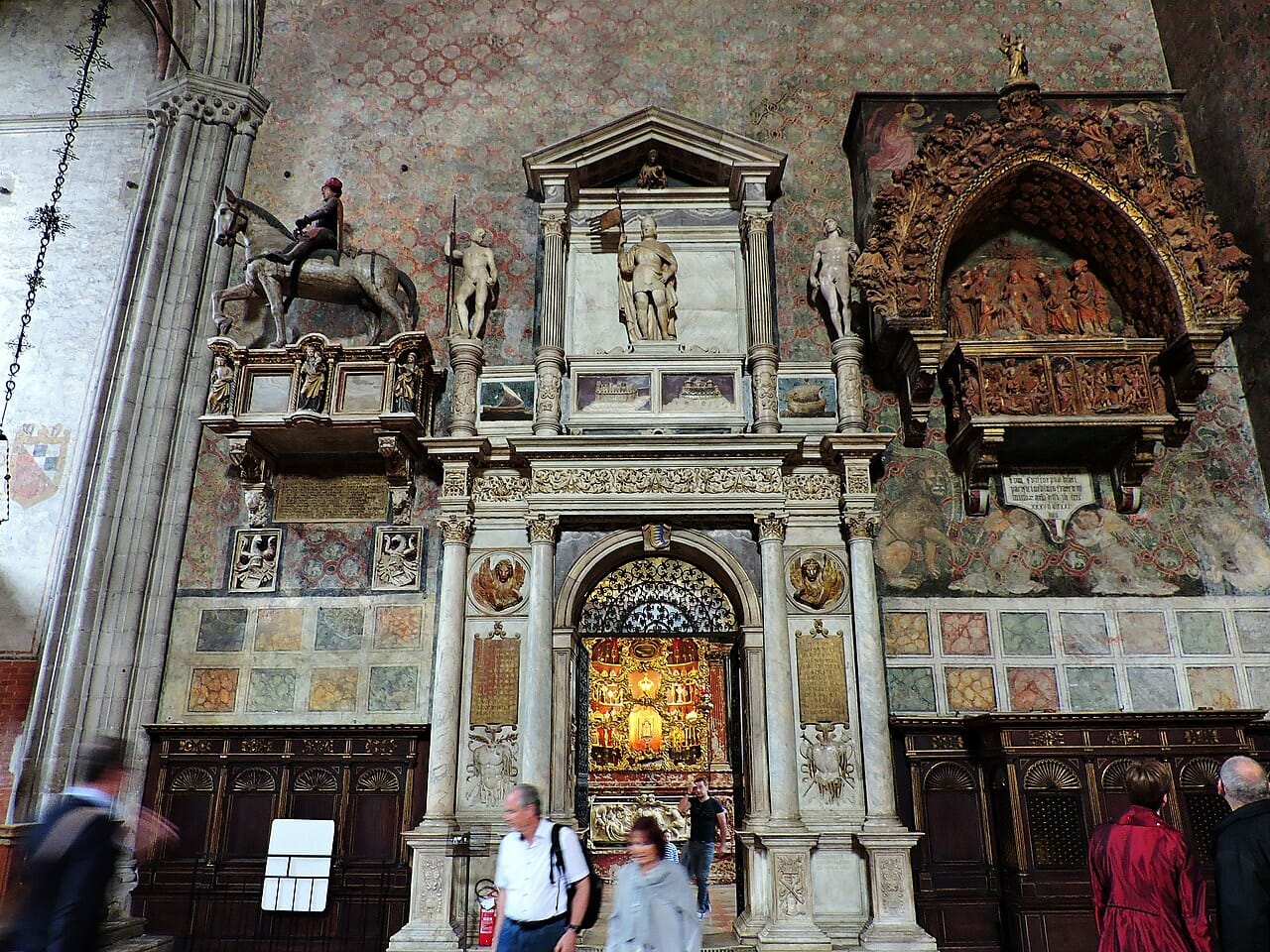
The Basilica of Santa Maria Gloriosa dei Frari is just as impressive inside as outside. Photo credit: Dimitris Kamaras
San Pantalon
Also known as the Chiesa di San Pantaleone Martire, this church might seem unassuming from the outside. It is a towering brick facade with no decoration. Tucked away near the University Ca Foscari, right in the center of Venice.
But you won’t want to skip out on this church, step inside to gaze at the beautifully painted ceiling. “The Martyrdom and Apotheosis of St Pantalon” is a work by Gian Antonio Fumiani completed at the end of the 17th century. The dark shades and bright sky create an effect that you have stumbled upon this scene and stand in awe at the figures towering over you.
Take a walk around, and you’ll catch even more works by favorite local artists like Veronese, Antonio Vivarini, and many more.

Chiesa di San Pantaleone Martire, located in Campo San Pantalon. Photo credit: Didier Descouens
Best ways to visit churches in Venice
Remember that in Italy, many churches require you to dress appropriately. If it is a hot day and you plan on wearing shorts or something that shows shoulders or mid drift, just pack a light scarf to bring along!
Buy a Chorus Pass for a self-guided experience
Many churches may be free to enter. However, there are 16 churches that are actually managed by the Chorus Association, and these do charge a small fee. This includes the Church of San Zaccaria, mentioned above.
While one church admission is only a few Euros, you can get a pass to enter all 16 for €12. For more information, you can contact the association at [email protected].
Join our exclusive, small group tours with expert guides
We offer several after-hours and exclusive experiences, such as the VIP Doge’s Palace Secret Passages Tour & St. Mark’s Basilica, where your guide provides a full tour of this impressive church, from the east-meets-west architecture to the eye-popping gold mosaics.
Another great option is our Exclusive Alone in St. Mark’s Basilica After Hours tour, which gives visitors the chance to explore the city’s most important Venetian church completely alone!

Join our Alone in St. Mark’s Basilica After Hours tour to experience this incredbile building in a way that few visitors can.
by Evelyn Hill
View more by Evelyn ›Book a Tour

Pristine Sistine - The Chapel at its Best
€89
1794 reviews

Premium Colosseum Tour with Roman Forum Palatine Hill
€56
850 reviews

Pasta-Making Class: Cook, Dine Drink Wine with a Local Chef
€64
121 reviews

Crypts, Bones Catacombs: Underground Tour of Rome
€69
401 reviews

VIP Doge's Palace Secret Passages Tour
€79
18 reviews

Legendary Venice: St. Mark's Basilica, Terrace Doge's Palace
€69
286 reviews









